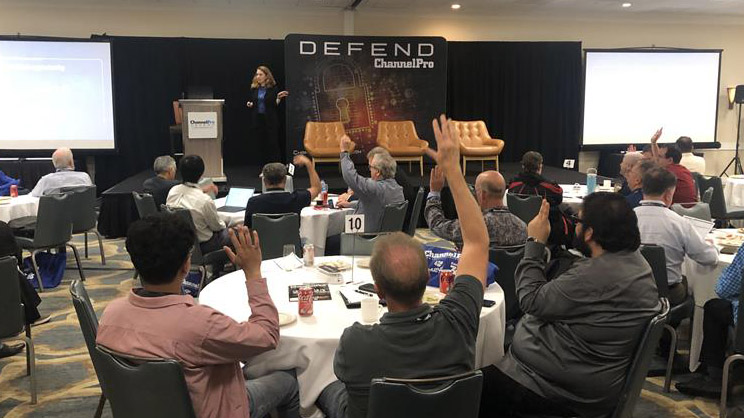NOT ONLY CAN IT BE LONELY at the top––it can be extremely busy. When channel pros grow beyond $1 million a year and acquire an increasing number of employees, they need a leadership structure that supports the founder. This requires an investment of time (and money) into developing the talent that will take them to the next level.
The first step is letting go. Benjamin Pearce, president and CEO of ACP Technologies, began building his leadership team about five years ago, when it became clear that he could no longer oversee everything. The MSP/MSSP is headquartered in West Seneca, N.Y., with a branch in San Antonio, Texas, has 28 employees, and serves clients across the country.
Currently, ACP’s leadership team includes Pearce, an IT director, an operations manager, a branch manager in Texas, and a comptroller. Only these positions directly report to Pearce, who admits that letting go and allowing others to lead was difficult, but worth it. “When you have the right people and you entrust them––and they know what they’re supposed to do in their role––all of a sudden you’re like, ‘Why didn’t I do that five years ago?'” he says. “But you’ve got to have the structure to be able to do it, and, obviously, the finances to get those people.”
Like Pearce, Michael Hornby didn’t start building his leadership team at Techmentum until it passed the $1 million mark. Last year, the Edison, N.J.-based MSP, which has six employees, made its first acquisition. With that deal came CTO Sue Fuqua. “The breadth of areas that a firm like mine is required to cover is increasing tremendously, and it’s difficult to impossible for a single leader to drive everything that needs to be done forward,” says CEO Hornby.
The next step is hiring a COO, and Hornsby is currently grooming one of his employees for the position. “The person that I’m considering has a similar vision [to mine] for how we want to grow, how we want things to be run, and how we view the need for technology,” he says. In transforming this individual contributor into a leader, Hornby will be gradually adding responsibilities and asking that person to provide increasing input into business decisions.
“Directed Autonomy” vs. Ultimate Freedom
Developing leadership skills at all levels of the company is a strategy that Peter Melby, CEO of Denver-based Greystone Technology, uses. As head of a $20 million MSP with 120 employees, Melby learned the importance of giving staff autonomy as he built his team. The key is hiring people with what he calls “ownership drive”––professionals who don’t need the boss’s help in making every decision presented to them.
Early on, however, Melby discovered that his version of autonomy was a little too broad. “Giving ultimate freedom and ultimate runway to do whatever you want is not autonomy,” he says. “Autonomy exists when you’ve set the boundaries, and the framework, and the direction for where things go, and then you allow people to have autonomy inside of that space that you’ve provided for them.” Melby calls this “directed autonomy.”
Part of this involves developing clear standard operating procedures (SOPs), but also giving employees the freedom to be discerning. “I think it’s excellent to have those processes, but we need to empower our team members to look at the situation for what it is, and make the commonsense decision,” Melby says. If an immediate client need can’t be fixed quickly enough through SOPs, the individual charged with resolving the problem should have the liberty to break some rules.
This practice should apply to all levels within a company, Melby says, from the office manager on up. His reason? When entry-level employees are encouraged to apply “ownership drive,” they’re developing leadership skills from the get-go.
“If you reserve [directed autonomy] only for people who have demonstrated that they can do it perfectly then you’re never going to get there, because people don’t have the practice,” he says. “A piece of it is being OK with the fact that the results aren’t perfect, but in the long run, you’re building something that doesn’t require you to make every decision.”
Getting Employee Buy-In
Building leaders also requires setting them up for success. Avtek Solutions is an eight-person MSP based in Allen, Texas, led by CEO Wayne Hunter, an operations manager, and a marketing manager. Hunter is planning to hire four more employees by year-end, including a services manager.
Getting employee buy-in for the services manager position is one of Hunter’s main concerns. His team is used to going directly to him with questions, and that hierarchy will change when the new role is filled. To ensure his staff is prepared for that switch, Hunter hosted an event late last year to collect employee input on what they need from a services manager.
The feedback Hunter received was largely unsurprising: His employees want a manager who can help them develop their careers; give them the tools they need to do their jobs; and provide support as they’re dealing with customers. The main if unspoken goal of this exercise, however, was to cultivate buy-in.
“They know this is coming and they had their chance to speak up and say what they need,” Hunter explains. “The biggest thing that came out of it was getting them to communicate so that they’re involved. It’s not just saying, ‘Here’s a new manager and you work for him.’ You don’t do that.”
Internal vs. External, High Performers vs. Leaders
Many channel pros feel most comfortable promoting existing employees into leadership positions. Melby believes that this is a good practice, especially in the early stages of building a leadership team. However, he cautions against developing a culture in which employees expect that just because they’ve worked at the company for a while, they will eventually become managers.
“We’ve found that when we try to grow only from the inside, we often end up in a position where someone has been around for a long time and they’ve helped us grow the way that we need to, but they’re not the right person to help us grow double or triple beyond where we’re at today,” Melby explains. “We have to be careful not to set the precedent or the expectation that everyone has unlimited leadership potential.”
Melby notes that MSPs tend to promote their best performers into leadership positions even when they lack the “leadership maturity” to build engaged teams, something that requires empathy and the ability to inspire people to pursue a shared vision. “It’s not about getting buy-in from my team at all costs, and it’s not about consensus,” he says. “It’s about earning that loyalty and respect.”
Finally, it can be tempting to develop leaders who are just like you, observes Pearce, who advises channel pros to avoid this mistake. “Don’t hire someone because you think you’re going to get along with them and that they’re going to do everything you tell them to do,” he says. “Hire someone [who] understands the challenges and who is not afraid to give you pushback.”
Image: iStock















